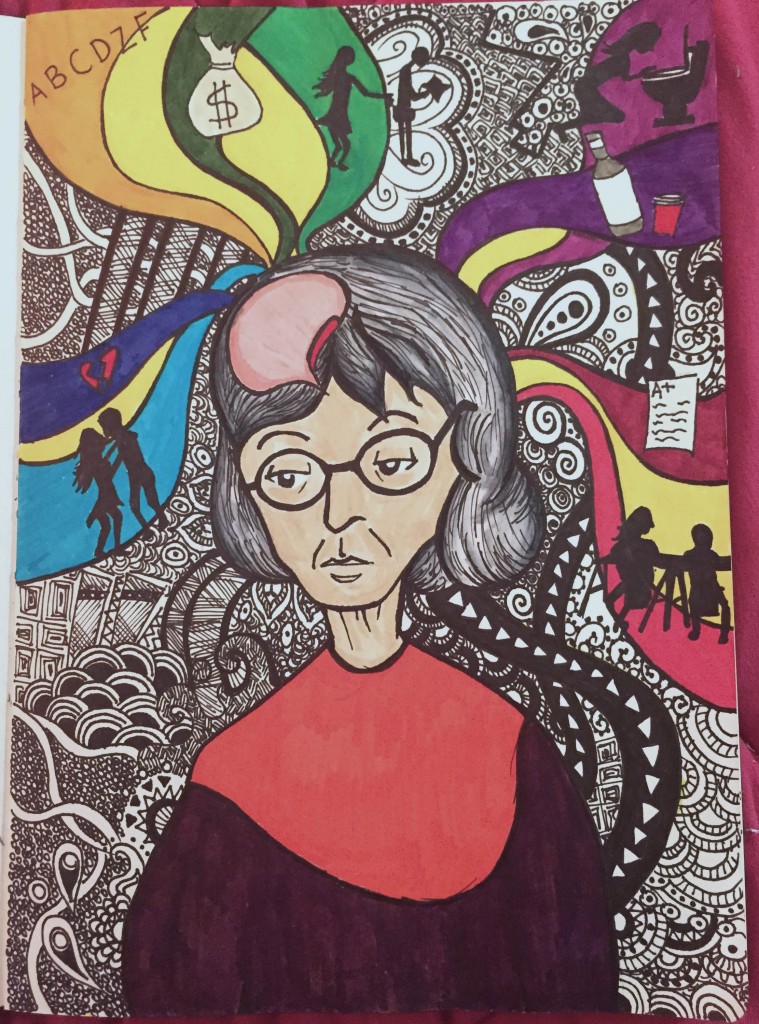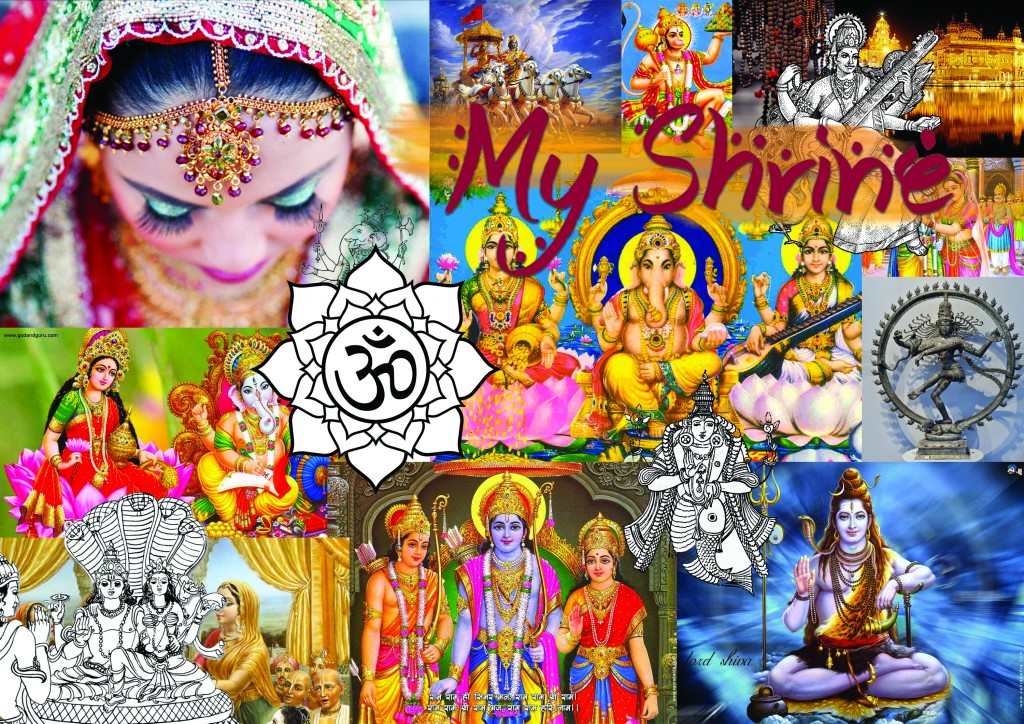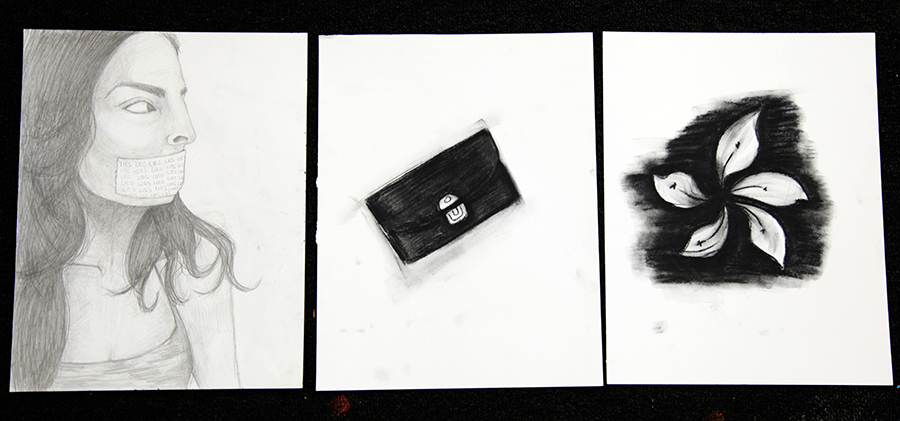Shrine Process + Research
Someone would traditionally create a shrine for a place of worship for sacred person or object. Occasionally the shrine contains sacred relics.
I’ve chosen to make a shrine of the culture I’ve left behind in India. Even though I try to incorporate it to my life today, its something that I’ve definitely lost because I left in grade 4. I’ve lost it because I’m not surrounded by it anymore. I’m memorializing it because I feel a disconnect from it, no matter how hard I try to embody my culture. I will design my shrine like a little temple that my mom owns at home. My parents are obviously more immersed into Indian culture and they try really hard to teach my sister and I, however we’ve grown up in a different environment so it will never be the same.
I have incorporated black and white sketches on my mood board because that is how my shrine is going to look like. I plan to make it out of slightly thicker card paper. I am more comfortable working in 2D but I do need to push myself when it comes to 3D work, so I thought this could be a good compromise. I get to still sketch but i will need to cut them out and glue them so it becomes into this three dimensional shrine. All the gods I will draw, will resemble a pop up card because it is 2D and i plan to glue the bottom to the shrine, that will also be made out of paper. To make it more personal, I would include photos of me as a child celebrating these festivals, also in black and white to go along with the whole aesthetic of this project. Its to represent the loss of color which essentially represents the loss of culture. My shrine will actually resemble what an Indian shrine looks like, a small temple that families have at home.
The materials I will need for this project are card paper, sharpies, pens, cutting knife and super glue. And of course my personal photos.
Bridge Project Part II: Mind Flaneur
I chose a memory which comes to my mind immediately when I think of “errors” because the part of the brain I focused on was the anterior cingulate cortex. The drinking age in Hong Kong is 18 so I was not breaking any laws but when I was out clubbing one night I had a really stuffed bag and I briefly remember having to hold my wallet separately. However after reaching back home in a taxi, I realized that my wallet was missing and I have no recollection of putting it down anywhere or dropping it. I went back and retraced my steps. It was still noisy, the music was loud and people were still dancing and drinking. My wallet contained this slip of paper that I needed to give for my new Hong Kong Permanent Residency Identification Card, so I panicked. The next morning, I kept avoiding the subject of my new ID card and overtime my parents asked for the slip I would change the subject. I felt so guilty. Then finally, I told them I lost the slip but I never confessed to losing my entire wallet because I was scared they would never trust me with anything again. To this day, they don’t know about how I lost my wallet and all my other ID cards and the money I earned from the job I was working that summer. The three objects I chose were a wallet, a small bag and the national Hong Kong flower thats on the identification card and any official document related to HK. I recall this memory in a sequence. However I chose to use charcoal as my medium because the whole thing was “messy,” or haphazard. Thinking about how I lost my wallet is a blur, but how I tried to find it and lied about it is completely clear. Its one of my most recent errors that is why I chose it.
Bridge Project: Mind Flaneur

The part of the brain I am going to focus on for this project is the anterior cingulate cortex (ACC), also known as ‘Area 25.’ It is located towards the front of the corpus callosum which is by the medial frontal lobe. Its main functions are of the following: decision-making, emotional regulation and regulation of physiological processes like blood pressure and heart rate. However, there are studies showing that this part also activates when it comes to error-detection or any type of shortfalls, as well as when there is any anticipation or preparation before a task-performance. An interesting fact regarding the ACC is that it can become active even when individuals are unaware of their errors.
How is the ACC and ones memory related? The ACC is necessary for recalling behaviors learned a month or more in the past, so strictly related to ones long-term memory. How the ACC contributes to the recall of remote memories is still unknown. As I mentioned before the ACC plays a vital role in error-detection and this is because location-wise it isclose to the amygdala; a part of the brain that deals with fear and emotion. The ACC plays an important role in reconsolidating contextual fear memory. Another part of the brain that is close to the ACC is the hypothalamus which is in charge of ones basic functions like body temperature, hunger, thirst, fatigue and sleep, these can be indicators of error detection as well. For example, if a person gets nervous their heart rate would increase and their body temperature might get warmer.
I chose to create an illustration of an older woman thinking about her past errors to represent how the ACC works; the older woman is symbolic towards the fact that it is related to ones long-term memory. The entire page is filled with doodles to portray confusion, and the way the page is packed is a metaphor for how ones life is “packed” with errors, that we may or may not know we committed and of course other happier memories; we associate color with happiness so I chose to do the doodles in a simple black and white. However, there is color in my illustration and this is just for artistic purposes. The errors I chose to represent are very universal so when one looks at the artwork they can find themselves resonating with one or maybe more errors.


